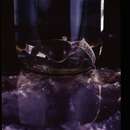Biology
provided by Arkive
The common name of this species refers to the extraordinary method of parental care. Mating occurred in the spring and the female then swallowed the eggs (4). Thus the larvae developed in her stomach; safe from digestion as the digestive system shut down completely (5). For the entire six to seven weeks of egg development the female did not eat, and when the young had metamorphosed into tiny frogs, they were expelled into the mouth and then crawled out and hopped away (4).
Feeding occurred both on land and in the water; small insects (2) were caught with the tongue, and the forelimbs were then used to manoeuvre the item into the mouth (2). The gastric-brooding frog was a strong swimmer, but it was not very active and often stayed still for hours, drifting or floating in the water (2).
Conservation
provided by Arkive
The southern gastric-brooding frog has been listed as Extinct by the Environment Protection and Biodiversity Conservation Act (EPBC) (2), and as Endangered in Queensland (4). Sadly, it seems likely that the secrets of this frog's amazing ability to 'switch off' the secretion of digestive acids have been lost forever.
Description
provided by Arkive
Only recently discovered, this Australian frog is now believed to be extinct. The body was grey on the back with variable darker and lighter patches, whilst the underparts were white with large creamy markings. There was a dark streak running from the eye to the forelimbs. The small, flattened head featured large, protruding eyes and the toes were fully webbed (2) (4).
Habitat
provided by Arkive
This species was aquatic; it inhabited rainforest creeks, pools and streams (2).
Range
provided by Arkive
Endemic to Australia, the southern gastric-brooding frog was first discovered in 1973, and occurred only in the Conondale and Blackall Ranges of southeastern Queensland at an altitude between 400 and 800 metres (2). No wild specimens have been recorded since 1981, and the last captive individual died in 1983 (4).
Status
provided by Arkive
Classified as Extinct (EX) by the IUCN Red List 2007 (1), and listed on Appendix II of CITES (3).
Threats
provided by Arkive
The southern gastric-brooding frog was first discovered in 1973, but it had vanished from the wild less than a decade later in 1981 (4). A number of explanations have been proposed to explain this startling decline, including drought, climate change and increased ultra-violet radiation (7). Since the end of the 1970s, a total of 14 frog species endemic to Australia have undergone dramatic and sudden declines, reflecting the global decline in amphibian populations. Recent analysis has indicated that the simultaneous declines of these species may be the result of a fungal infection (6).

